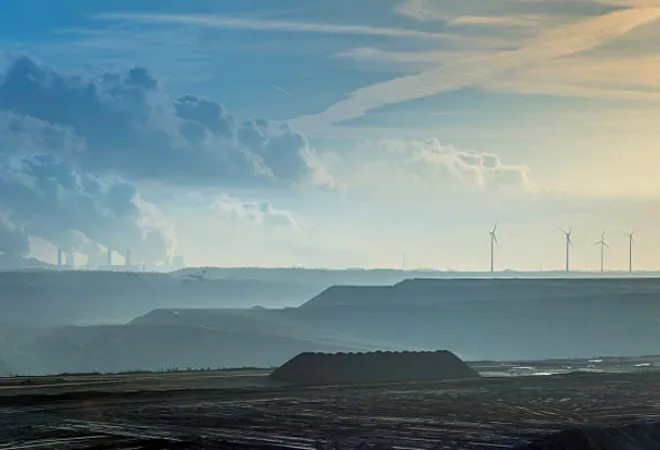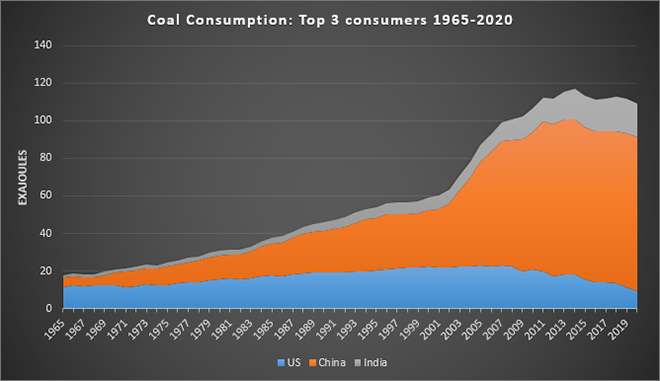
This article is part of the series Comprehensive Energy Monitor : India and the World
At COP26 in Glasgow, India’s last-minute intervention to change, “phase-out of unabated coal power and inefficient fossil fuel subsidies” to “phase-down of unabated coal power and inefficient fossil fuel subsidies” in the draft text of the Glasgow climate pact received widespread criticism. Many missed the fact that India merely introduced the term “phase-down” from the text of the agreement between China and the US made earlier at Glasgow. Even without India’s intervention, the draft text contained sufficient legal ambiguity in the words “unabated” and “inefficient” to get away with continued use of coal and subsidies for fossil fuels. More importantly, the text did not specify a date by which coal and fossil fuel subsidies would have to be phased out which meant that the use of coal and fossil fuel subsidies could continue indefinitely. India became the convenient villain in the emotion-driven climate activism that requires one to sustain itself. But not long ago, the wealthier world “phased-up” coal in the energy mix of the developing world.
The coal-nuclear strategy
Reports that emerged in the early 1980s from high profile global conferences such as the Workshop on Alternative Energy Strategies, the Istanbul World Energy Conference and the voluminous report ‘Energy in a Finite World’ by the International Institute for Applied Systems Analysis (IIASA), which included the contribution of over 250 scientists, concluded that the most important development in the 21st century would be the exponential growth of the developing world—then labelled the third world—energy needs.
India became the convenient villain in the emotion-driven climate activism that requires one to sustain itself. But not long ago, the wealthier world “phased-up” coal in the energy mix of the developing world.
By year 2000, developing countries were expected to be consuming energy of the same order of magnitude as Western European or US consumption in 1980s. A vicious cycle of growth in developing world energy needs that leads to heavier demand on the petroleum market which increases oil prices which in turn aggravates wealthier economies and limits growth in the developing countries was anticipated. This trend towards catastrophic world energy growth gave rise to a common consensus to accelerate nuclear programmes and the exploitation of coal in both industrialised and industrialising countries by year 2000. Once this was accomplished, the developing world, including the Organisation of Petroleum Exporting Countries (OPEC) were expected to be net importers of energy and the Organisation for Economic Cooperation and Development (OECD) countries net energy exporters. This reversal of energy flows was based essentially on the exploitation of coal and nuclear technology that the wealthy world would export to the poorer world. Most of known reserves of coal and most of the technologies to exploit coal and nuclear power were with western countries.
Energy forecasts
The fundamental implication was that the future of energy growth was already fully determined and that the only possible path-namely, a coal-nuclear strategy must be pursued without fail. The proposals called for a mechanical transposition of the solution that had been applied in the industrialised countries: Reduction of the demand for traditional energies, and the introduction of commercial energies with priority given to large inter-connected grids for electricity. This outlook clearly neglected many aspects that were important for future projections for the developing world: (1) The specific features of the energy service needs and links between energy and specific development paths of industrialising countries (2) the relevance of taking energy as a homogeneous product the requirements of which were linked to economic growth by a technical elasticity coefficient (3) the versatility of oil as a fuel and its competitiveness vis-à-vis other fuels.
Western economies looked at the traditional sector of developing countries strictly as a technical reality that would progressively disappear following the introduction of commercial energy sources. They estimated energy demand in synthetic units (tonnes of oil equivalent or megawatts ) that masked the real composition of energy needs and limited the possibilities of modulating energy profiles.
In general, long-run forecasting models assumed that there exist underlying structural relationships in the economy that vary in a gradual fashion. In the real world, discontinuities and disruptive events abound as demonstrated, most recently by the pandemic and earlier by the global financial crisis. The longer the time frames of the forecast, the more likely it is that key events will change the underlying economic and behavioural relationships that all models attempt to replicate.
Western economies looked at the traditional sector of developing countries strictly as a technical reality that would progressively disappear following the introduction of commercial energy sources.
Though the projected reality from models did not materialise, development in the Western mould has transferred the general pattern of Western economic growth and affluence to the developing world. Increase in the price of oil made developing countries increasingly dependent on developed countries for additional foreign currency to pay for petroleum products. Countries with oil and gas resources remained dependent on Western capital and technologies for developing their resources. Despite the rule of the market, the system of international interdependencies remained one of hierarchical dependence, one of asymmetric vulnerability, i.e., unequal ability of the interacting units (countries) to inflict damage on one another, therefore, making the welfare of some countries dependent on the will of others. The World Energy Outlook brought out annually by the International Energy Agency (IEA) routinely predicts a supply crunch in oil followed by a dramatic increase in the price of oil. This is a hidden call on OPEC to invest in increasing oil production. When OPEC obliges, the West along with the rest of the world benefits even though this means risky capital investment by OPEC that critically depends on higher oil prices.
Sustaining hierarchies
Past energy forecasts may not have been accurate, but they shaped and colonised the future in which the industrialised world came up on top. Today, energy forecasts predict sinking of small island states and even world extinction caused by rising fossil fuel use and the resulting climate calamity. The call to confine coal to history by COP26 at Glasgow is driven by such forecasts. Coal-dependent countries are forced to call for financial assistance and technology-transfer from developed countries so that their shift towards renewable energy sources can be accelerated. Rather than climbing on top of the energy hierarchy to become owners of knowledge and patents for transformative energy technologies developing countries are once again lining up to become large consumers of new and expensive energy technologies imported from the wealthier world.
 Source: BP Statistical Review of World Energy 2021
Source: BP Statistical Review of World Energy 2021
The views expressed above belong to the author(s). ORF research and analyses now available on Telegram! Click here to access our curated content — blogs, longforms and interviews.





 PREV
PREV




